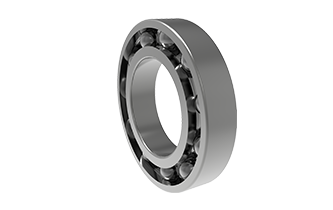Deep Groove Ball Bearing

Описание товара
Deep Groove Ball Bearing
Deep groove ball bearing has a wide range of sizes and are the most commonly used roll bearings with simple structure, standardized machining process, reliability, durability and high-cost performance. Deep groove ball bearings can bear axial load in both radial and light axial directions and are easy to install at low maintenance costs.
They have low friction torque and are optimized for low vibration and low noise, which are suitable for high-speed operation.
Applications: electric motors and generators, agriculture, material transportation, industrial gearboxes, food and beverage, industrial pumps, industrial fans, vehicles, etc.
Single Row Deep Groove Ball Bearing
The inner and outer rings have tracks of circular cross-section with a radius slightly larger than that of the rollers - balls.
Single Row Deep Groove Ball Bearing With Filling Slot
Single row deep groove ball bearings with filled slots have filling slots on both the inner and outer rings compared to standard deep groove ball bearings, which means they can accommodate more balls.
Double Row Deep Groove Ball Bearing
Each of the inner and outer rings has two rows of tracks with circular cross-sections. The rolling body structure is similar to a pair of single-row ball bearings.
Thin Section Deep Groove Ball Bearing
Thin section deep groove ball bearings are mainly used in space-limited working conditions. Such bearings are available in both open and closed configurations.
Key Features of Deep Groove Ball Bearing
Deep groove ball bearings provided by THB bearings, as one of the most professional double row deep groove ball bearings suppliers in China, have the features of high radial load, high speed and long service life.
High radial load: The outer ring with high wall thickness can not only withstand high radial load, but also reduce deformation and bending stress when working as a roller.
Withstanding overturning moment: Double-row ball roller bearings can withstand greater overturning moment compared to single-row ball roller bearings.
Long service life: The convex design of the outer ring surface can be greatly improved to cope with the possible inclination of the outer ring on the working track surface, or where the edge stress needs to be minimized.
Relatively high speed capacity.
Angular Contact Ball Bearing vs Deep Groove Ball Bearing
Angular contact ball bearings and deep groove ball bearings have the same structure, which are composed of inner ring, outer ring, rolling elements, and raceways. But these two types of bearings are quite different. Where are the differences?
1. The accuracy is different: the outer raceway surface of angular contact ball bearing is different from that of deep groove ball bearing. The raceways of angular contact ball bearings are not the same high, on one side high and low on the other side. The accuracy of angular contact ball bearings is higher than that of deep groove ball bearings.
2. The load capacity is different: angular contact ball bearings can bear radial and axial forces. Single row angular contact ball bearings can bear radial force while bearing one side's axial force, so single row angular contact ball bearings are generally paired used. Back-to-back, face-to-face arrangement can bear the radial force while bearing the axial force of the double term; and when used in pairs, it can bear double the axial force of one side. Deep groove ball bearings can withstand radial forces, but only a slight axial force.
The rotational speeds of the angular contact ball bearings and deep groove ball bearings are relatively high. The difference between them is mainly due to the different raceway surfaces. The rolling elements of angular contact ball bearings form a contact angle with the raceway surface. According to the different sizes of contact angle which can be divided into 15°, 25°, 40°, etc., the greater the contact angle, the greater the axial force it will bear.

